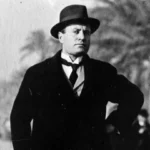Big Nose George: Outlaw, Victim, or Macabre Legend?
The Wild West, a period of untamed landscapes and even wilder characters, continues to captivate our imaginations. Among these figures, Big Nose George, born George Parrott, stands out. His life, a turbulent blend of daring heists and a controversial demise, still ignites debate about the boundaries between justice, revenge, and the macabre.
Born on March 20, 1834, George Parrott, later infamous as Big Nose George, was more than a petty thief; he was a notorious cattle rustler and highwayman, his name whispered with a mix of fear and fascination in saloons across the Wyoming Territory. However, it was his alleged involvement in a botched train robbery in 1878 that cemented his dark legacy. The robbery went tragically wrong, resulting in a shootout that left two lawmen, Robert Widdowfield and Tip Vincent, dead.
For two years, Big Nose George lived as a fugitive, a ghost evading the grasp of the law. As with many outlaws, his luck eventually dwindled. In 1880, he was apprehended for robbery alongside his accomplice, Charlie Burris, also known as “Dutch Charley.”
A Date with the Gallows and the Fury of a Mob
Captured and sentenced to hang on April 2, 1881, Big Nose George was imprisoned in Rawlins, Wyoming, awaiting his fate. However, the legal system would never get its chance to deliver judgment. On March 22, 1881, fueled by grief, anger, and a thirst for vengeance, an enraged mob stormed the jailhouse where George was held. They dragged him out, delivering a brutal and immediate form of frontier justice—lynching him from a telegraph pole.
A Gruesome Afterlife: From Outlaw to Medical Oddity
The macabre tale of Big Nose George doesn’t conclude with his death. In a bizarre and unsettling twist, his body became an object of morbid curiosity. Two local doctors, Thomas Maghee and John Eugene Osborne, driven by what some argue was scientific ambition and others condemn as perverse fascination, obtained his remains for dissection.
Their actions, shocking by today’s standards, raise uncomfortable questions about the ethical boundaries of the time. Was it purely scientific inquiry, or did it cross the line into something far more sinister? Dr. Maghee reportedly gifted the top portion of George’s skull to his 16-year-old assistant, Lillian Heath, who later became Wyoming’s first female physician. The lower portion of his skull, along with the rest of his bones, was placed in a whiskey barrel and buried, its exact location remaining a mystery.
Osborne’s actions, however, would become even more controversial. He reportedly had shoes fashioned from the skin of George’s legs, a gruesome act that would forever link him to the outlaw’s legacy.
The Legend Endures: Whispers of Shoes and a Governor’s Inauguration
Rumors persist, whispered like ghost stories through the decades, that Osborne, who was elected Wyoming’s first Democratic Governor in 1892, wore the infamous shoes made from Big Nose George’s skin to his inaugural ball. While the whereabouts of the shoes remain unknown, their legend casts a long shadow.
Unsettled History: Echoes in a Wyoming Museum
In 1950, during the construction of the Rawlins National Bank, the whiskey barrel containing Big Nose George’s remains was unearthed, reawakening the unsettling tale. Today, his skull, the macabre centerpiece of this grim story, is on display at the Carbon County Museum in Rawlins, Wyoming.
Big Nose George: A Legacy of Unanswered Questions
The story of Big Nose George is more than a true crime tale from the Wild West. It’s a stark reminder of the complexities of frontier life, where the lines between justice and revenge were often blurred. It forces us to confront the darkness that can reside within humanity, even within those who swore oaths to heal and uphold the law.
Was Big Nose George a ruthless killer who deserved his fate, or was he denied true justice, becoming a victim of the brutal realities of his time? The debate continues, fueled by the unsettling relics of his existence. His skull, a silent witness to a bygone era, serves as a stark reminder of the violence that shaped the West and the ethical quandaries that continue to haunt us today.
- Unlocking Francis Alexander Shields’ Finance Empire: A Comprehensive Biography - July 12, 2025
- Unveiling Francis Alexander Shields: A Business Legacy - July 12, 2025
- Francis Alexander Shields’ Business Career: A Comprehensive Overview - July 12, 2025















